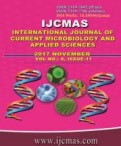


 National Academy of Agricultural Sciences (NAAS)
National Academy of Agricultural Sciences (NAAS)

|
PRINT ISSN : 2319-7692
Online ISSN : 2319-7706 Issues : 12 per year Publisher : Excellent Publishers Email : editorijcmas@gmail.com / submit@ijcmas.com Editor-in-chief: Dr.M.Prakash Index Copernicus ICV 2018: 95.39 NAAS RATING 2020: 5.38 |
Rainfall data for the period 1957 - 2015 is used to analyze nakshatra-wise, monthly, seasonal and annual variability of rainfall. The analysis of daily rainfall data (1957-2015) indicates that the average annual rainfall for the Aurad region will be 830.5 mm. The lowest and highest recorded annual rainfall was 280.4 and 1337.7 mm respectively. The annual rainfall at Aurad region was distributed as 660.2 mm, 101.1 mm, 59.8 mm and 9.4 mm in monsoon (June- September), post monsoon (October - December), summer (March - May) and winter (January - February) season respectively. The standard deviation and coefficient of variation for mean annual rainfall was 241.8 mm and 29.1 per cent respectively. The highest mean rainfall of 201.9 mm with coefficient of variation of 59.4 per cent was highest in August month followed by July (182.2 mm) with coefficient of variation of 62.5 per cent. However the lowest coefficient of variation of 58.4 per cent was noticed during June month with mean rainfall of 122.5 mm indicating lesser variability. Among the nakshatras Makha nakshatra has recorded the highest mean rainfall of 98.6 mm and the lowest rainfall (13.6 mm) was from Swati nakshatra. The coefficient of variation was highest in (164.4 per cent) Chitta nakshatra while Pushya and Pubbha nakshatra has recorded the lowest coefficient of variation of 76.8 per cent. The highest rainfall of 378.7 mm was recorded by the Makha nakshatra during 2003 and very lowest rainfall (113.2 mm) by Swati nakshatra during 1973.
 |
 |
 |
 |
 |